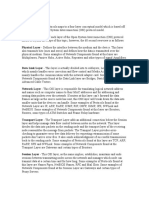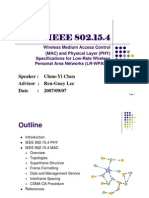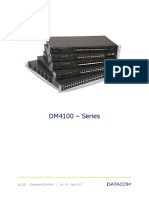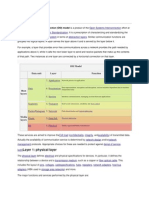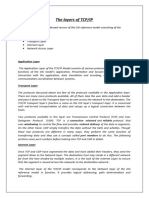6LoWPAN Protocol Stack - Nikhil
Uploaded by
Nikhil PS6LoWPAN Protocol Stack - Nikhil
Uploaded by
Nikhil PS6LoWPAN Protocol Stack
6LoWPAN protocol stack are comprises of 802.15.4 physical (PHY) and medium
access control (MAC) layer, adaptation layer, network layer, transport layer and
application layer.
The main difference between 6LoWPAN and OSI protocol stacks is the emergence
of adaptation layer. This layer is assumed to perform fragmentation/reassembly,
header compression and mesh addressing
6LoWPAN Physical Layer
Provides two services- PHY data service and PHY management
service interfacing to the physical layer management entity
(PLME) service access point (SAP) known as the PLME-SAP
Provides transmission of data packets across radio channel
6LoWPAN Protocol Stack
PHY management service interface, which offers access to every
layer management function and maintains a database of
information on related personal area networks
PHY layer protocol data unit of IEEE 802.15.4 is compliant with a
maximum payload of 127 bytes.
The PHY is prefixed by a Synchronization Header (SHR) fields
encompasses the Preamble Sequence and Start of Frame
Delimiter fields, and a PHY Header (PHR) encompasses of Frame
Length/Reserved. The SHR condone the receiver to achieve
symbol synchronization. As a result, the SHR, PHR, and PHY
payload form PHY packet.
(Preamble- 1s and 0s for receiving clock sync , SFD-to mark new
incoming frame)
Data Link Layer (MAC layer)Provides two services: the MAC data service and the MAC
management service interfacing to the MAC sub-layer
management entity (MLME) service access point (SAP)
(MLMESAP).
The MAC data service is to let the transmission and receiving of
MAC protocol data units (MPDU) across the PHY data service
Data frame-data transfer, beacon frame-generated by
coordinator for synchronization, Command frame-management
entity, acknowledgement frame-for acknowledgement
6LoWPAN Protocol Stack
MAC Header (MHR) has frame control, sequence number and
address information fields
4 frame structures for MAC layer: data frame, beacon frame,
acknowledgement frame and MAC command frame
Security Enabled Subfield:
The security Enabled subfield is 1 bit in length, and it shall be set
to one if the frame is protected by the MAC sublayer and shall be
set to zero otherwise.
Frame Pending subfield:
The frame pending subfield is 1 bit in length and shall be set to
one if the device sending the frame has more data for the
recipient
Acknowledgment Request subfield:
The acknowledgment request subfield is 1 bit in length and
specifies whether an acknowledgment is required from the
recipient device on receipt of a data
Sequence number always enabled for security.
The information of IPv6 is allocated in the payload which is the
MAC service data unit (MSDU).
MFR has Frame Check Sequence (FCS).
FCS field:
Frame Check Sequence (FCS) is 2 octets in length and contains a 16-bit ITU-T CRC
(Cyclic Redundancy Check).
6LoWPAN Protocol Stack
Adaptation Layer
.
Has three primary elements1. Fragmentation and reassembly
IPv6 packet size over IEEE 802.15.4 is 1280 bytes .However, the
packet size is larger than IEEE 802.15.4 frame. In this condition,
IPv6 packet size unable to be encapsulated in one IEEE802.15.4
frame. 802.15.4 Protocol data units have variety of sizes. It
depends on the overhead occurred [8]. Maximum Transmission
Unit (MTU) for IEEE 802.15.4 is 127 bytes. This frame has 25
bytes, header, footer and addressing, overheads. In addition,
security header imposed by Link Layer adds 21 bytes overhead
when AES-CCM-128 is used. Due to this matter, one IPv6 that
need to be transmitted over IEEE 802.15.4 frame has to be
divided to more than 16 fragments
The fragmentation header is 4 or 5 bytes long and contains
datagram size (indicates size of the original datagram),
datagram tag (identifies all fragments of a particular datagram)
and
datagram offset (indicates the location of the fragment within the
datagram).
6LoWPAN Protocol Stack
2. Header compression
The IEEE 802.15.4 frame which has a maximum packet size of
128 bytes; instead IPv6 header size is 40 bytes, User Datagram
Protocol (UDP) and Internet Control Message Protocol (ICMP)
header sizes are both 4 bytes, fragmentation header add another
5 bytes overhead. Without compression, 802.15.4 is not possible
to transmit any payload effectively.
3. Routing
There are a number of existing routing protocols in 6LoWPAN
like:RPL, 6LoWPAN Ad-hoc On-Demand Distance Vector (LOAD),
Multipath based 6LoWPAN Ad-hoc On-Demand Distance Vector
(MLOAD), Dynamic MANET On-Demand for 6LoWPAN Routing
(DYMO-Low), Hierarchical Routing (Hi-Low), Extended Hi-Low and
Sink Adhoc On-Demand Distance Vector Routing (SAODV).
6LoWPAN Protocol Stack
Network LayerThe 6LoWPAN network layer provides the internetworking
capability to sensor nodes.
Route over routing decision
6LoWPAN Protocol Stack
In route-over scheme, each link layer hop is an IP hop and each
node acts as IP router. The packet is forwarded hop by hop from
source to destination between these links. The packets payload is
encapsulated in IP header.
Transport LayerIn this layer, there are two types of transport protocols; User
Datagram Protocol (UDP) and Transmission Control Protocol (TCP)]
At the source side, either TCP or UDP connections is established
based on the application
The data from application layer is organized in either UDP or TCP
segments and attached to created process (TCP or UDP
processes). At the destination side, after the UDP or TCP
segments is received from the network layer, the transport layer
processes the segment probably based on the protocol used and
send it up to the application layer
Application LayerThe 6LoWPAN application layer uses a socket interface for a
specific application. Each 6LoWPAN application opens a socket
which is then used to receive or send packets. Each socket is
associated with a protocol, TCP or UDP, and source and/or
destination ports
6LoWPAN Protocol Stack
You might also like
- Clinical Applications: Syngo Vessel ViewNo ratings yetClinical Applications: Syngo Vessel View8 pages
- Wireless Reviewof6LoWPANRoutingProtocolsNo ratings yetWireless Reviewof6LoWPANRoutingProtocols11 pages
- Application Application Transport Transport Internet Network Link Data Link PhysicalNo ratings yetApplication Application Transport Transport Internet Network Link Data Link Physical18 pages
- Media Access Control - Wikipedia, The Free EncyclopediaNo ratings yetMedia Access Control - Wikipedia, The Free Encyclopedia3 pages
- Jason Zandri : TCP/IP Protocol Within Windows XP ProfessionalNo ratings yetJason Zandri : TCP/IP Protocol Within Windows XP Professional29 pages
- Subject Title: Code: NAT121 Credit Units: 3 Instructor: Jerico D. MacatangayNo ratings yetSubject Title: Code: NAT121 Credit Units: 3 Instructor: Jerico D. Macatangay11 pages
- List of All The Existing Network ProtocolsNo ratings yetList of All The Existing Network Protocols12 pages
- PrinterFriendlyViewPack - PHP PackId 170516No ratings yetPrinterFriendlyViewPack - PHP PackId 17051624 pages
- The Seven Layers of Networking 17.01.2024No ratings yetThe Seven Layers of Networking 17.01.20243 pages
- DM4100 - Series: Datasheet DM4100 - Ver 35 - Apr/2017No ratings yetDM4100 - Series: Datasheet DM4100 - Ver 35 - Apr/201723 pages
- New Product: Corecess 6808 - APC Advanced IP DSLAMNo ratings yetNew Product: Corecess 6808 - APC Advanced IP DSLAM13 pages
- Supplemental Reading For Broadband ProtocolsNo ratings yetSupplemental Reading For Broadband Protocols21 pages
- Winter 2012 Master of Computer Application (MCA) - Semester 6 MC0087 - Internetworking With TCP/IP - 4 Credits (60 Marks) 1. What Is Fragmentation? Explain Its SignificanceNo ratings yetWinter 2012 Master of Computer Application (MCA) - Semester 6 MC0087 - Internetworking With TCP/IP - 4 Credits (60 Marks) 1. What Is Fragmentation? Explain Its Significance8 pages
- OSI Model Data Unit Layer Function: ApplicationNo ratings yetOSI Model Data Unit Layer Function: Application6 pages
- HCSCA101 HCNA-Security-CBSN Chapter 1 Network Security Overview V2.5No ratings yetHCSCA101 HCNA-Security-CBSN Chapter 1 Network Security Overview V2.541 pages
- Verilog Modeling of Wi-Fi MAC Layer For TransmitterNo ratings yetVerilog Modeling of Wi-Fi MAC Layer For Transmitter6 pages
- 1 - OSI Model: Network Revision - Reference ModelNo ratings yet1 - OSI Model: Network Revision - Reference Model5 pages
- Performance Enhancement of High Speed WlansNo ratings yetPerformance Enhancement of High Speed Wlans9 pages
- Performance Enhancement of High Speed WlansNo ratings yetPerformance Enhancement of High Speed Wlans10 pages
- East Africa University Bosaso, Puntland Somalia Faculty of Medicine Communicable Disease MR Buruj Ali SaladNo ratings yetEast Africa University Bosaso, Puntland Somalia Faculty of Medicine Communicable Disease MR Buruj Ali Salad42 pages
- MDCT: Technical Principles and Future Trends: Mathias ProkopNo ratings yetMDCT: Technical Principles and Future Trends: Mathias Prokop8 pages
- Whole Unit 2 - Crude Oil and Refining Product TestingNo ratings yetWhole Unit 2 - Crude Oil and Refining Product Testing113 pages
- D88 - 07 Standard Test Method For Saybolt ViscosityNo ratings yetD88 - 07 Standard Test Method For Saybolt Viscosity7 pages
- Elementary Number Theory Homework Solutions100% (1)Elementary Number Theory Homework Solutions5 pages
- Chapter 22: Current and Resistance: SolutionsNo ratings yetChapter 22: Current and Resistance: Solutions5 pages
- Handbook of Hydrophone Element Design TechnologyNo ratings yetHandbook of Hydrophone Element Design Technology2 pages
- Application Application Transport Transport Internet Network Link Data Link PhysicalApplication Application Transport Transport Internet Network Link Data Link Physical
- Media Access Control - Wikipedia, The Free EncyclopediaMedia Access Control - Wikipedia, The Free Encyclopedia
- Jason Zandri : TCP/IP Protocol Within Windows XP ProfessionalJason Zandri : TCP/IP Protocol Within Windows XP Professional
- Subject Title: Code: NAT121 Credit Units: 3 Instructor: Jerico D. MacatangaySubject Title: Code: NAT121 Credit Units: 3 Instructor: Jerico D. Macatangay
- DM4100 - Series: Datasheet DM4100 - Ver 35 - Apr/2017DM4100 - Series: Datasheet DM4100 - Ver 35 - Apr/2017
- New Product: Corecess 6808 - APC Advanced IP DSLAMNew Product: Corecess 6808 - APC Advanced IP DSLAM
- Winter 2012 Master of Computer Application (MCA) - Semester 6 MC0087 - Internetworking With TCP/IP - 4 Credits (60 Marks) 1. What Is Fragmentation? Explain Its SignificanceWinter 2012 Master of Computer Application (MCA) - Semester 6 MC0087 - Internetworking With TCP/IP - 4 Credits (60 Marks) 1. What Is Fragmentation? Explain Its Significance
- HCSCA101 HCNA-Security-CBSN Chapter 1 Network Security Overview V2.5HCSCA101 HCNA-Security-CBSN Chapter 1 Network Security Overview V2.5
- Verilog Modeling of Wi-Fi MAC Layer For TransmitterVerilog Modeling of Wi-Fi MAC Layer For Transmitter
- East Africa University Bosaso, Puntland Somalia Faculty of Medicine Communicable Disease MR Buruj Ali SaladEast Africa University Bosaso, Puntland Somalia Faculty of Medicine Communicable Disease MR Buruj Ali Salad
- MDCT: Technical Principles and Future Trends: Mathias ProkopMDCT: Technical Principles and Future Trends: Mathias Prokop
- Whole Unit 2 - Crude Oil and Refining Product TestingWhole Unit 2 - Crude Oil and Refining Product Testing
- D88 - 07 Standard Test Method For Saybolt ViscosityD88 - 07 Standard Test Method For Saybolt Viscosity









